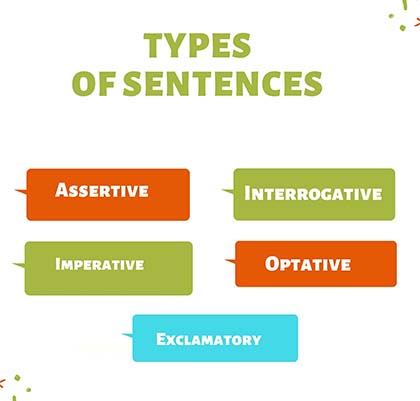Sentences are fundamental to any language, whether English or any other language. We human beings express ourselves or interact with each other by producing several sentences. A sentence is formed by combining several words or parts of speech, such as nouns, pronouns, prepositions, adjectives, verbs, etc.
Normally, a sentence contains a subject (noun, pronoun) and a verb. Sometimes a sentence consists of only one word, depending on the context. Suppose you ask me, “Are you busy now”? I reply to you, “Yes.” Here ‘yes’ still is a sentence. Now the question is, what is the definition of sentences in English? Let us analyze the definition of a sentence in English elaborately. First of all, let’s see what scholars think about sentences in English grammar.
Definition of a Sentence by Scholars
Quick Navigation
J.C. Nesfield: A combination of words that makes a complete sense is called a sentence.
Wren and Martin: A group of words which makes a complete sense is called a sentence.
Now we can say a word or a group of words that contains a subject (what or whom the sentence is about) and a predicate (what is said about the subject) and acknowledges the proper meaning and understanding is called a sentence in English. For Example:
- He is a good boy.
- Are they playing football?
- Please do something for me.
- May you be happy in your entire life.
- Wow! We won the match today.
Note: A sentence can be longer than a single subject and a single predicate.
Types of Sentences in English
English sentences are of five types according to meaning. They are:
- Assertive sentence/ Declarative
- Interrogative sentence
- Imperative sentence
- Optative sentence
- Exclamatory sentence
1. Assertive Sentence/ Declarative
A sentence that depicts a fact or statement is called an Assertive sentence. Usually, these types of sentences always state the fact or declare something. For example:
- Zinat is a good girl.
- He is going to school.
- I have a dog.
- They are going to watch a cricket match.
- My father bought a shirt for me.
Note: All the sentences explain facts or statements. So a sentence that describes the statement of someone or something is called an Assertive sentence.
Pattern: Subject+verb+object+extension
2. Interrogative Sentence
A sentence that demands a question is called an Interrogative sentence. Interrogative sentences always ask for questions for any reason. For example:
- Are you having your breakfast?
- Does he meet with his friends?
- Don’t they walk in the morning?
- Has she gone to a parlor?
- Did your father a government team member?
Note: Every Interrogative sentence opens with an auxiliary verb and ends with an interrogative mark”?”
Pattern: Interrogative sentences can be formed in three ways:
1. If a sentence contains with “be” verb (am, is, are, was, were), “have” verb (have, has, had), and modal verb (shall, should, will, would, can, could, may, might, etc.) then the verb will place before the subject.
2. If a sentence contains no helping verb (mentioned above), then do, does, and did will place before the subject.
- Do will be placed for present indefinite tense (the subject should be a first and second person)
- Does will also be placed for present indefinite tense (the subject should be third person singular number)
- Did will be placed for past indefinite tense (the subject can be any person)
3. If a sentence contains who, which, whom, whose, what, why, when, where, how much, how many, etc., then those pronouns will place before the subject.
3. Imperative Sentence
A sentence describing a command, request, or ask to do something is called an Imperative sentence. For example:
- Open the window.
- Make good food.
- Read the book.
- Let us do the work.
- Let me not agree with him.
Note: Usually Imperative sentence opens with a “verb” or “let” and the subject remains implicit.
Pattern: Verb+object+extension
4. Optative Sentence
A sentence that expresses any wish or player is called an Optative sentence. For Example:
- May Almighty bless you.
- May he long live.
- May God save you from danger.
- May my mother come round soon.
- Wish you reach your desired destination.
Note: An optative sentence opens with “may” in some cases “may” can be implicit. For example: Long live the man.
Pattern: May+Assertive=Optative sentence.
5. Exclamatory Sentence
A sentence that expresses feeling or emotion is called an exclamatory sentence. An exclamatory sentence always takes the exclamatory symbol (!)
- Alas! My grandfather is no more in the world.
- Hurrah! I get a new job.
- Wow! I have seen a sweet baby.
- What a beautiful bird this is!
- How happy the man is!
Note: If an exclamatory sentence contains with ‘how’, or ‘what’ then the verb will place after the subject and sentence’s ending.
Pattern: Hurrah! alas! ah! wow! etc.+ Assertive= Exclamatory sentence.
Caution: Every sentence can be divided into two parts:
- Affirmative
- Negative
1. Affirmative: A sentence that agrees with something or someone is called affirmative.
2. Negative: A sentence that disagrees with something or someone is called a negative sentence.
Rules of Negative Forms
We can make a sentence negative in three ways:
(1) If a sentence forms with a ‘be’ verb (am, is, are, was, were), ‘have’ verb (have, has, had), and ‘modal’ verb (can, could, shall, should, will, would, may, might) then ‘not’ will place after those verbs. For example:
- He is not an intelligent boy.
- My friend could not attend the place.
- They were not performed well.
- She was not singing songs at a concert.
- I have not traveled by train yet.
- Mr. Jonshon had not got in the right direction.
- It would be best if you did not believe anything blindly.
Note: ‘Not’ is placed after all the auxiliary verbs.
(2) If a sentence forms without a helping verb (mentioned above), then the ‘do’ verb (do, does, did) will place according to tense and number, and the main verb remains unchangeable. ‘Not’ will be placed in the middle of both the ‘do’ and the ‘main’ verb. For example:
- I do not agree with the matter.
- He does not play hockey.
- She did not attentive to her study.
Note: ‘Do’ verb is placed according to the tense and number.
(3) We can transform a sentence from affirmative to negative by using ‘no’ before a noun and ‘not’ before an adjective. For example:
- No man can live alone.
- He has no money.
- The boy has not a good attitude.
- She is not tolerable.
After completing the lesson, we will understand the definition of a sentence in English grammar. We will also learn classifications, examples, and patterns of all sentences in English. However, you are suggested to follow all the details about Sentences in English carefully.
Read more: Direct and Indirect Speech Rules and Examples
Sentences Quiz

Azizul Hakim is the founder & CEO of englishfinders.com. He is a passionate writer, English instructor, and content creator. He has completed his graduation and post-graduation in English language and literature.






Hlo Thanks for this
Welcome dear